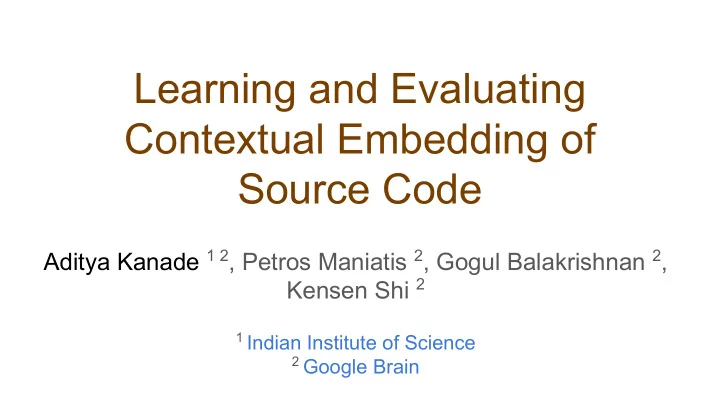

Learning and Evaluating Contextual Embedding of Source Code Aditya Kanade 1 2 , Petros Maniatis 2 , Gogul Balakrishnan 2 , Kensen Shi 2 1 Indian Institute of Science 2 Google Brain
General-Purpose Representations of Source Code ● Success of learned representations (e.g., ELMo, GPT, BERT, etc.) in NLU ● Source code is a formal description of an executable task. ● Source code is a means to communicate developer intent. ○ Meaningful identifier names ○ Natural-language documentation ○ Convey a lot of semantic information ● Could the following code be buggy? number_of_batches = batch_size / number_of_examples 2
CuBERT: Code Understanding BERT * Can we exploit characteristics of source code to learn general-purpose representations that can be used effectively in downstream tasks? Pre-train a deep bidirectional Transformer encoder from unlabeled code. Use the pre-training objectives, masked language modeling (MLM) and next-sentence prediction (NSP), popularized by BERT. Design and evaluate on a new benchmark of six code-understanding tasks -- including five classification and one multi-headed pointer prediction task. * BERT: Pre-training of Deep Bidirectional Transformers for Language Understanding 3
Experimental Results Q1: How do contextual embeddings compare against word embeddings? CuBERT outperforms BiLSTM models initialized with pre-trained source-code-specific Word2Vec embeddings by +2.9% to +22%. Q2: Is Transformer (without pre-training) all you need? CuBERT outperforms Transformers trained from scratch by +5.8% to +23%. Q3: What is the effect of reduced supervision? CuBERT achieves results comparable to the baselines with 1/3rd or 2/3rd of training data, and within 2 or 10 fine-tuning epochs (the default being 20 epochs). 4
Experimental Results Q4: How does the context length affect CuBERT’s performance? Increasing context length (128 -> 256 -> 512) tends to improve the performance. Q5: How does CuBERT perform on the more complex task of predicting a two-headed pointer in comparison to SOTA approaches? CuBERT achieves +33% (absolute) localization+repair accuracy in comparison to (Vasic et al. 2019) and +6.2% (absolute) in comparison to (Hellendoorn et al., 2020) on the corresponding datasets. 5
Experimental Setup Output label Task-specific 6.6 Million files 2 Billion words prediction layer GitHub Pre-training Pre-trained Python files corpus CuBERT model Layers=24 Hidden dim=1024 Attention heads=16 Program Subword Input example Total Parameters=340M vocabulary vocabulary 50K subwords 10.2 Million words 6
New Benchmark of Code-understanding Tasks Built using the ETH Py150 corpus (Raychev et al. 2016). Motivated in part by code-understanding tasks studied in the literature. ● Swapped operands (binary classification) (Pradel & Sen 2018) ● Wrong binary operator (binary classification) (Pradel & Sen 2018) ● Exception-type (multi-class classification) ● Function-docstring mismatch (sentence-pair classification) (Louis et al. (2018) ● Variable-misuse (binary classification) (Allamanis et al. 2018) ● Variable-misuse localization and repair (multi-headed pointer prediction) (Vasic et al. 2019) 7
Example of Wrong Binary Operator Classification def__gt__(self,other): if isinstance(other,int) and other==0: return self.get_value()>0 return other is not self Correct operator : < Visualization of attention weights at the last layer 8
Example of Exception Type Classification try: subprocess.call(hook_value) return jsonify(success=True), 200 except __HOLE__ as e: return jsonify(success=False, error=str(e)), 400 Expected label : OSError Multi-class classification with 20 top exception types as class labels. 9
Example of Function Docstring Classification Sentence #1: 'Get form initial data.' Sentence #2: def __add__(self, cov): return SumOfKernel(self, cov) Sentence-pair classification problem 10
Example of Variable Misuse Tasks Repair pointer def on_resize(self, event): event.apply_zoom() Localization pointer Variable event is used incorrectly instead of self. 11
Dealing with Code Duplicates Open-source projects are replete with code duplicates. This can: ● Affect the reported model performance. ● Result in information leak between pre-training and fine-tuning corpora. ● Bias pre-training towards duplicated code. Remedy code duplication by: ● Deduplicating the fine-tuning corpus in the fashion of Allamanis (2018) using Jaccard similarity over sets/multi-sets of tokens. ● Remove files with duplicates in the fine-tuning corpus from pre-training. ● Deduplicate the pre-training corpus. 12
Related Work Representation learning for programs ● Structured representations like abstract syntax trees (Alon et al., 2019) and data-flow/control-flow information (Allamanis et al., 2018; Hellendoorn et al., 2020) used in specific software engineering tasks. ● An upcoming work by Feng et al. (2020) aims at solving NL-PL tasks by pre-training a BERT model on paired NL description and code, in a multi-lingual setting. CuBERT pre-training and fine-tuning (e.g., function-docstring task) also involves both code and natural language. 13
Conclusions and Future Work We present the first pre-trained contextual embedding of source code. Our model, CuBERT, shows strong performance against baselines. We hope that our models and benchmarks will be useful to the community. Pre-training using structured representations of code, such as ASTs and graphs, that encode different types of information (e.g., data-flow and control-flow) will be an interesting future direction. We envision more innovations on the pre-training setup, reduction in model size and pre-training cost, and novel applications of the pre-trained models. 14
Recommend
More recommend